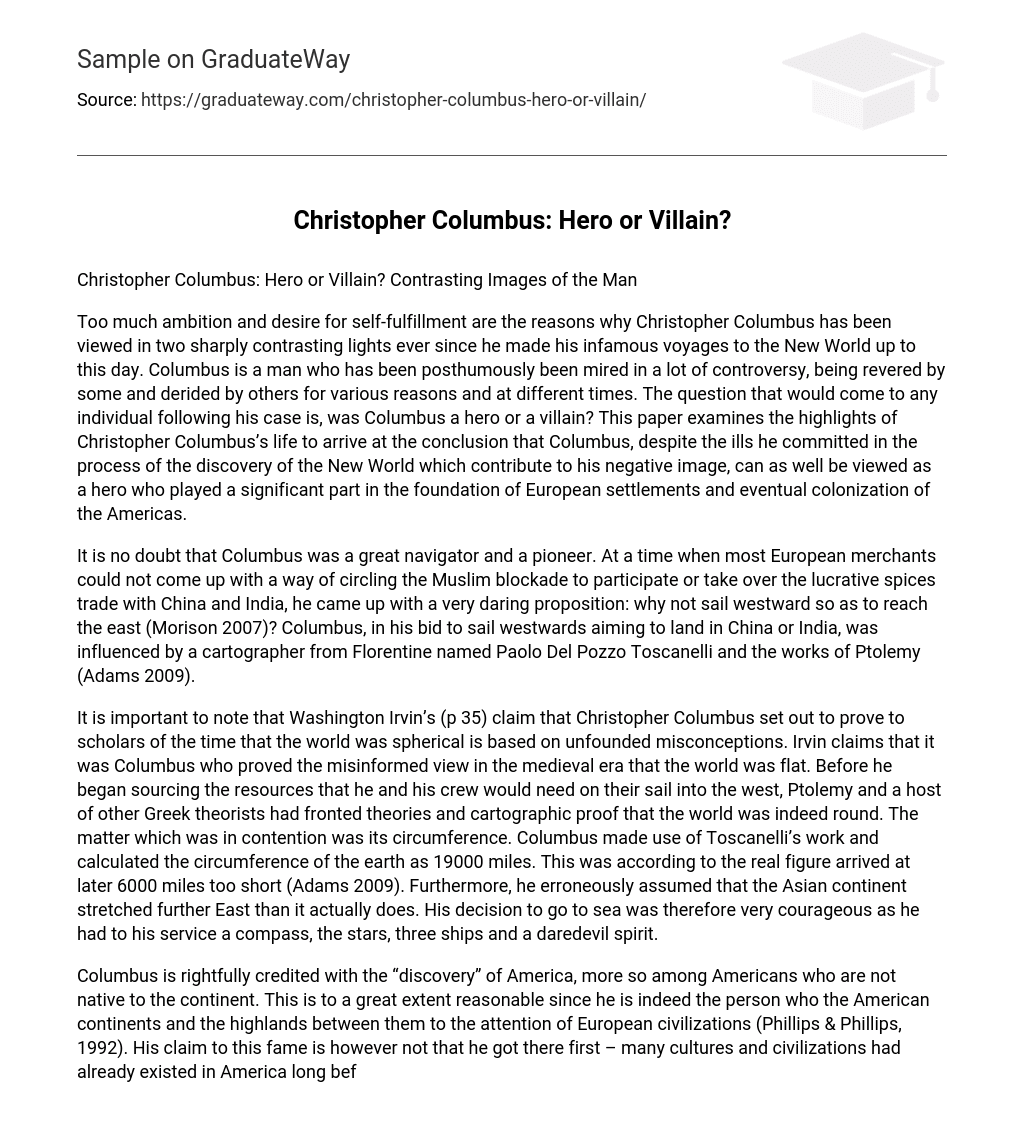Christopher Columbus: Hero or Villain? Contrasting Images of the Man.
Christopher Columbus has been viewed in two sharply contrasting lights ever since he made his infamous voyages to the New World. Too much ambition and desire for self-fulfillment are the reasons behind this. Columbus is a man who has been posthumously mired in controversy, being revered by some and derided by others for various reasons at different times. The question that arises is whether Columbus was a hero or a villain? This paper examines the highlights of Christopher Columbus’s life to arrive at the conclusion that despite committing ills during the discovery of the New World which contribute to his negative image, he can also be viewed as a hero who played an essential role in the foundation of European settlements and eventual colonization of America.
It is no doubt that Columbus was a great navigator and pioneer. During a time when most European merchants could not find a way to circle the Muslim blockade to participate in or take over the lucrative spice trade with China and India, he came up with a daring proposition: why not sail westward to reach the east (Morison 2007)? In his bid to sail westwards aiming to land in China or India, Columbus was influenced by Paolo Del Pozzo Toscanelli, a cartographer from Florence, and the works of Ptolemy (Adams 2009).
It is important to note that Washington Irving’s claim (p. 35) that Christopher Columbus set out to prove to scholars of the time that the world was spherical is based on unfounded misconceptions. Irvin claims that it was Columbus who proved the misinformed view in the medieval era that the world was flat. However, before he began sourcing resources for his journey west, Ptolemy and a host of other Greek theorists had already put forth theories and cartographic proof that the world was indeed round. The matter in contention at this time was its circumference.
Columbus made use of Toscanelli’s work and calculated the circumference of the earth as 19,000 miles. This figure later turned out to be 6,000 miles too short (Adams 2009). Furthermore, he erroneously assumed that the Asian continent stretched further east than it actually does.
Despite these miscalculations, Columbus’ decision to set sail into unknown waters with only a compass, stars, three ships and a daredevil spirit was incredibly courageous.
Columbus is rightfully credited with the “discovery” of America, especially among Americans who are not native to the continent. This is reasonable since he was the one who brought the American continents and the highlands between them to the attention of European civilizations (Phillips & Phillips, 1992). However, his claim to fame is not solely based on being there first – many cultures and civilizations had already existed in America long before Columbus arrived at its shores. Even Vikings from the Western world had already arrived here. The difference between him and his predecessors is that he chose to stay and spread Western Civilization and Christianity to the New World. His vision and ambition for these lands altered history forever, defining what we know as America today.
What brings to the fore a villainous Christopher Columbus are the things he did on land rather than at sea. Christopher Columbus, along with a group of military men, Christian missionaries, and settlers, literally demolished the social institutions and lives of the native people they encountered in the Americas (Adams 2009). Furthermore, he attempted to deceptively lay claim to his obsession of discovering a sea route from the western coast of Europe to Asia by forcing his crew to swear that they had actually landed in China after sailing west.
To fulfill his lie that the New World was abundant with gold, he issued an order to every native over 14 years of age to find a specific amount of precious metal every day. Those who could not comply had their hands chopped off. Many natives who fled his tyranny were hunted down and killed or starved to death (Phillips & Phillips, 1992). Rape and forced marriages became very common, and the natives could not resist the scourge of diseases brought by the Westerners. The native population dropped tremendously by the turn of the 16th century. It was this paranoia that brought about his downfall as he was arrested and shipped back to Spain.
Christopher Columbus was a courageous and brave navigator who, armed with limited knowledge and equipment, embarked on a voyage across the Atlantic Ocean that very few sailors of his time would dare to undertake. His obsession with finding a sea route to Asia by sailing west from the coast of Europe brought the New World to the attention of the Western world. This eventually led to the colonization of the Americas (Adams 2009) and permanently changed world history.
However, Columbus’ ambition got the best of him, and he became a tyrant who enslaved American natives and destroyed their institutions. As such, he will be viewed as a hero by some but as a villain by others, especially as scholars increasingly analyze his role in devastating and reinventing America.
References
Adams, C. K. (2009). Christopher Columbus: His Life and His Work. Charleston, SC.
BiblioBazaar, LLC.
Irving, Washington. (1830). Life and Voyages of Christopher Columbus. New York, NY.
Braziller.
Read Admiral of the Ocean Sea: A Life of Christopher Columbus by S. E. Morison (2007).
Books.
Phillips, W. D., and Phillips, C. R. (1992). The Worlds of Christopher Columbus. New York.
NY: Cambridge University Press.





